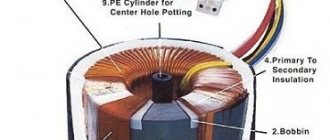Good day everyone! When calculating and designing a transformer, it is necessary to take into account the electromagnetic characteristics and features of its design with thermal and geometric characteristics. Therefore, the main task in design is to analyze the specified properties and determine the optimal dependencies that guarantee obtaining the required result.
In the last article I looked at the geometric characteristics of the transformer, in this article I will talk about the electromagnetic parameters.
To assemble a radio-electronic device, you can pre-make a DIY KIT kit using the link.
The given transformer parameters
For theoretical analysis of a transformer, it is not very convenient to use real values of the main parameters of the transformer. To do this, use the given parameters that characterize the transformer if the number of turns N of the primary w1 and secondary w2 windings is equal. Usually the reduction is carried out to the primary winding. To convert real parameters to given ones, a transformation coefficient k is used equal to
The number of turns is adjusted together with the actual values of the main parameters.
The main parameters include the resistance of the windings R, their voltages U and currents I, as well as the resistance of the magnetizing circuit, which characterizes the transformer core. The designation of the given values is usually accompanied by a top stroke
The point of the reduction is that the number of turns does not affect the operating principle of the transformer, but for analysis it is more convenient to use the same number of turns.
What is transformation ratio?
One of the main parameters of a transformer is its transformation ratio. Let's consider what its meaning is. To do this, we accept the assumption that the magnetic stray field is reduced to a minimum and is practically equal to zero. Then the primary and secondary windings are penetrated by the same magnetic flux PV . And in accordance with the law of electromagnetic induction, the electromotive force at the terminals of the transformer windings is determined by the following expressions
where E1 and E2 are the emf at the terminals of the primary and secondary windings, respectively,
ω1 and ω2 – number of turns of the primary and secondary windings, respectively,
dFV/dt – rate of change of magnetic flux.
Then, equating the last part of both expressions, we obtain the relation that determines the value of the transformation coefficient
where n is the transformation coefficient.
Thus, the transformation ratio n is the ratio of the number of turns of the primary ω 1 to the number of turns of the secondary ω 2 winding.
Depending on the value of the transformation ratio, the transformer can be step-down when n > 1, and step-up when n < 1. In a step-up transformer, the EMF of the secondary winding is greater than in the primary E1 < E2, and in a step-down transformer – E1 > E2.
Transformer equivalent circuit
The basis of the transformer equivalent circuit is the fact that the secondary current does not create the main magnetic flux in the core. Since this is counteracted by the load part I of the current of the primary winding, which has the same magnetizing force as the current of the secondary winding I2 but opposite in direction. And the main magnetic flux is created by the magnetizing part I0 of the primary winding current.
The secondary winding current I2 and the load part I of the primary winding current create magnetic leakage fluxes, indicated in the equivalent circuit by reactances x1 and x2.
Transformer equivalent circuit.
Based on these principles, an equivalent transformer circuit, or as it is also called an equivalent circuit, is constructed. A transformer with one secondary winding is shown here and has the following designations: ZH - load resistance, ZI - internal resistance of the signal source, EI - source emf, E - reduced winding emf, xCi - capacitance of the transformer windings, XL - inductive reactance of the magnetizing circuit, RC – active resistance of the magnetizing circuit.
Short circuit mode
During the operation of a transformer, situations sometimes arise when its secondary winding is short-circuited. In this case, a current appears in it that exceeds the rated one by tens of times. In this case, they talk about the operation of the transformer in short circuit mode . This mode is emergency and unacceptable, since overheating of the transformer windings causes their destruction. Thus, the short circuit mode is characterized by the following voltage and current parameters
To test a transformer and determine some of its parameters a short circuit experiment , in which the secondary winding is short-circuited, and such a voltage is applied to the primary winding that the rated current is established in the secondary winding. In such a case, the voltage across the primary winding is called normal short circuit voltage . The value of this voltage in the transformer parameters is usually expressed as a percentage of the rated voltage of the primary winding
where USC is the normal short circuit voltage,
UH – rated voltage on the primary winding.
Currents in the equivalent circuit of a transformer
In accordance with the diagram, the magnetizing current I0 consists of two parts: reactive I0r, which ensures the creation of magnetic flux Φ (Φ = I0rw), and active I0a, which affects power losses in the core Рс (Рс = I0a2RC).
Then the following relations take place for the magnetizing circuit
Due to the nonlinearity of the transformer core parameters, the XL and RC values are inconvenient to use. For calculations, the magnetic characteristics of the core and the dependences on induction B of the following parameters are used: the effective strength of the magnetizing field NE (A/m), the specific magnetizing power of the core p0 (W/kg) and the specific losses pi (W/kg). Then, based on the known weight of the core Gc and the effective length of the magnetic field line lE, we determine the losses in the core PC = piGc and the magnetizing reactive power Р0L = p0Gc
When analyzing the operation of a transformer, it is more convenient to use relative values of currents, most often relative to the load current I. Then the relative currents will be designated: the active component Ia of the current I through ia, the reactive component Ir through ir, the primary winding current I1 through i1, the magnetizing current I0 through i0 and its components are i0r and i0a. They will be determined by the following expressions
Transforming the previous expressions we get
Since in most cases the transformer is dominated by active load Ir≈0, the relative current of the primary winding will be
In the case of insignificant losses in the core i0a<< i0r we obtain
4.8.LOSSES AND EFFICIENCY COEFFICIENT
An operating transformer always has both magnetic and electrical losses. Magnetic losses consist of losses due to eddy currents and hysteresis.
The magnitude of these losses depends on the voltage u1 and magnetic induction B. We can assume that when U1 = const, ron = B2. They do not depend on the load, i.e. are permanent. Electrical losses in the windings, on the contrary, are variable, i.e.:
where pkn corresponds to losses during a short circuit of the transformer. If the short circuit losses at rated load are known, then the electrical losses can be determined using the formula:
where is the load factor of the transformer. Total transformer losses:
Efficiency is the ratio of the active power P2 taken from the transformer to the active power P1 supplied to the transformer:
Power P2 is calculated using the formula:
where is the rated power, kW.
Power
then the efficiency of the transformer
or
As can be seen from the last formula, the value of efficiency. depends on the transformer load. In addition, the E.P.D. the higher the cos f2. The maximum efficiency corresponds to a load at which magnetic losses are equal to electrical losses:
Hence the load factor value corresponding to the maximum efficiency is:
Usually the E.P.D. has a maximum value at b = 0.5 - 0.6. Then h= 0.98 - 0.99.
Resistances in the equivalent circuit of a transformer
Let's consider the resistance of the windings in the equivalent circuit. In different types of transformers, certain types of resistance may have different significance. In most cases, active resistances Ri are of primary importance. However, in powerful transformers the leakage resistance Xi is significantly higher than the active one. The active resistance of the winding is determined in the standard way, through the resistivity of the conductor ρ, the number of turns of the i-th winding wi, the average length of the turn of the i-th winding lwi (m) and the cross-section of the conductor of the i-th winding qi (mm2)
In the case of transformers of high and high frequencies, the active resistance of the windings begins to increase as the frequency increases. This occurs due to the surface effect (skin effect) and the influence of neighboring winding conductors (proximity effect). These factors are reflected using the additional loss coefficient kr, which I discussed in the article on power losses in chokes.
Let's return to the reactances Xi and Xci. Reactance Xi is caused by leakage fluxes and is calculated through leakage inductance Lsi
where ω is the circular frequency,
f – alternating current frequency.
In most cases it is necessary to know the total leakage inductance Ls reduced to the primary winding. Approximately, it is twice the leakage inductance or reduced secondary winding
where wi is the number of turns of the i-th winding,
lwi – average turn length of the i-th winding, cm,
mф – number of rods carrying the winding of one phase (for ST mф = 2, for the rest mф = 1),
msi – number of winding sections, for an unsectioned winding msi = 1,
h – windings (rod height without yoke), cm,
∆ob – thickness of inter-winding insulation, cm,
Cki – thickness of one coil, on one side (for BT Cki = s, for ST, TT Cki = s/2), cm,
KT – transformation ratio.
The capacitances in the equivalent circuit of the transformer and the corresponding capacitance resistances Xci combine several types: interwinding capacitance Cb, interlayer capacitance Ccl and capacitance C1C between the first winding layer and the core. The following expressions will allow you to calculate different types of containers:
- interwinding capacitance
where εa is the dielectric constant of the substance between the core and the first winding layer,
di – diameter of the winding wire without insulation,
lw – average length of the transformer coil turn,
∆1С – distance between the core rod and the winding closest to it,
wi – number of turns of wire in the i-th winding,
nsl i – number of layers of conductors in the i-th winding.
— interlayer capacity
- capacitance between the first winding layer and the core
a, b – width and thickness of the transformer core rod.
To reduce these capacitances to the primary winding, you must use the following expressions
They are all combined into a total equivalent capacitance Se and brought to the corresponding input.
The reactive parameters Xi, Xci, Lsi and Ci are in most cases parasitic and negatively affect the operation of the transformer. But at low frequencies (up to several kHz) their influence is insignificant and is not taken into account in practical calculations.
Equivalent circuit parameters
Let's consider the parameters of equivalent circuits in Figure 1 with k = w1 / w2 [see equality (1)]. Reduced mutual inductance based on equalities (6) and (10), presented in the article “Inductance of transformer windings and electromagnetic scattering” and equality (19), this article
or based on expression (4), presented in the article “Inductance of transformer windings and electromagnetic dissipation”
| (20) |
The last term of expression (20) is very small compared to the first, and therefore with sufficient accuracy
| M12' ≈ Lс1. | (21) |
Accordingly, according to expression (3) presented in the article “Transformer Voltage Equations” and expressions (11), (19), (21) of this article,
x12' = k × x12 = ω × k × M = ω × M12' ≈ ω × Lс1
or
| x12' ≈ xс1 = ω × w12 / Rµc. | (22) |
Consequently, the resistance x12' is, with great accuracy, equal to the self-induction resistance of the primary winding from the flux closing along the magnetic circuit.
Branches 1 – 2 of equivalent circuits in Figure 1 are called magnetizing branches. The magnetizing current flowing through these branches
| creates the resulting magnetizing force of the transformer windings Fres = w1 × (I1 + I2') = w1 × I1 + w1 × I2' = F1 + F2, which in turn creates a resulting rod flow with amplitude Fs. The voltage on these branches in accordance with expression (22) of this article and expression (3) presented in the article “Principle of operation and types of transformers” that is, equal in value and inversely in sign to the electromotive force E1, which is induced in the primary winding by the resulting flux of the magnetic circuit, or the main flux of the transformer, and lags behind it by 90°. The leakage inductance of the primary winding, according to expressions (9) and (10), presented in the article “Inductance of transformer windings and electromagnetic leakage” and expression (17) of this article, S1 = L11 – k × M = Lc1 + Lв1 – k × Mc – k × Мв . But based on equations (4) and (6) presented in the article “Inductance of transformer windings and electromagnetic dissipation” That's why
Similarly, according to expressions (9) and (10) presented in the article “Inductance of transformer windings and electromagnetic scattering” and expression (18) of this article But based on equations (5) and (6), presented in the article “Inductance of transformer windings and electromagnetic scattering” and therefore
Thus, the leakage inductances S1, S2 and S2' and the leakage inductances at k = w1 / w2 are determined by magnetic fluxes that are closed mainly through the air. However, the second terms of equalities (23) and (24) cannot be neglected in comparison with the first ones, and therefore flows closed through the air can be called scattering flows only conditionally.
|
4.9.THREE-PHASE TRANSFORMERS
4.9.1. General provisions
To transform energy in three-phase systems, either a group of three single-phase transformers is used, in which the primary and secondary windings are connected by a star or delta, or one three-phase transformer with a common magnetic core. Three-phase transformers can have different connections between the primary and secondary windings. All the beginnings of the primary windings of the transformer are designated in capital letters: A, B, C; the beginning of the secondary windings - in small letters: a, b, c. The ends of the windings are designated respectively: X, Y, Z and x, y, z. The terminal of the output zero point when connected by a star is designated by the letter O. The most common winding connections are star (Y) and delta (D), and the primary and secondary windings can have either the same or different circuits. If, when connecting the windings with a star, the zero point is output, then such a connection is called “star with zero” (Yo). In Fig. 4.9.1 shows a three-phase transformer when the Y/Y windings are turned on.











